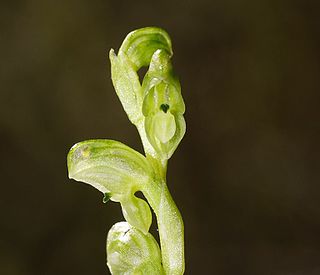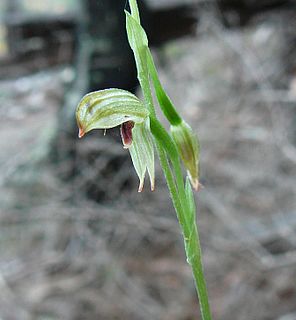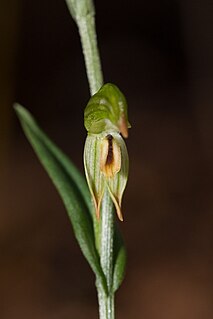
Pterostylis coccina, commonly known as the scarlet greenhood, is a species of orchid endemic to eastern Australia. As with similar greenhoods, the flowering plants differ from those which are not flowering. The non-flowering plants have a rosette of leaves flat on the ground but the flowering plants have a single flower with leaves on the flowering spike. In this species, the rosette leaves are relatively large and dark green, and the flowers are white, and bluish-green or red. It grows in New South Wales and north-eastern Victoria.

Pterostylis melagramma, commonly known as the black-stripe leafy greenhood is a plant in the orchid family Orchidaceae and is endemic to south-eastern Australia. Individual plants have either a rosette of three to six leaves or a flowering spike with up to twenty flowers and five to seven stem leaves. The flowers are translucent green with faint darker green lines and have a brownish-yellow labellum with a dark stripe.

Pterostylis cycnocephala, commonly known as the swan greenhood, is a plant in the orchid family Orchidaceae and is endemic to south-eastern Australia. It has a rosette of leaves and up to 24 green flowers which have a labellum with a dark green, beak-like appendage. It is widespread and common from the Darling Downs in Queensland to Tasmania, usually growing with grasses.

Pterostylis bicolor, commonly known as the black-tip greenhood, is a plant in the orchid family Orchidaceae and is endemic to south-eastern Australia. It has a rosette of leaves and when flowering, three to ten well-spaced, bright green flowers with a blunt, greenish-black appendage on the labellum. It is similar to the swan orchid, Pterostylis cycnocephala but that species has a beak-like appendage and crowded flowers.

Pterostylis tunstallii, commonly known as Tunstall's greenhood or granite greenhood is a plant in the orchid family Orchidaceae and is endemic to south-eastern Australia. Flowering plants have up to ten transparent green flowers which have a dark brown, insect-like labellum with a blackish "head". Non-flowering plants have a rosette of leaves on a short stalk but flowering plants lack the rosette, instead having five to eight stem leaves.

Pterostylis aneba is a species of orchid endemic to south-eastern Australia. It is a recently described and poorly-known greenhood similar to Pterostylis alpina and P. monticola. It has a rosette of fleshy leaves at the base of the plant and a single green and white flower. It grows in alpine and sub-alpine habitats.

Pterostylis jonesii, commonly known as the montane leafy greenhood, is a plant in the orchid family Orchidaceae and is endemic to a small area of south-eastern Australia. Individual plants have either a rosette of three to six leaves or a flowering spike with up to eleven flowers and five to seven stem leaves. The flowers are translucent green with faint darker green lines and have a brownish-yellow labellum with a dark stripe.
Pterostylis agrestis is a plant in the orchid family Orchidaceae and is endemic to Victoria. It has a rosette of leaves and when flowering, up to fourteen transparent green flowers with a blunt, greenish-black appendage on the labellum. It is similar to the black-tip greenhood, Pterostylis bicolor but that species has larger, less crowded flowers and is found in different habitats.
Pterostylis clivicola is a plant in the orchid family Orchidaceae and is endemic to a small area near the border between New South Wales and Victoria. It has a rosette of leaves and up to fourteen green flowers which have a labellum with a dark green, beak-like appendage.
Pterostylis conferta, commonly known as the leprechaun greenhood or basalt midget greenhood, is a plant in the orchid family Orchidaceae and is endemic to Victoria. It has a rosette of leaves at the base of the flowering stem and up to sixteen pale green flowers in a short, crowded spike. It is a very rare orchid, similar to P. mutica, its distribution much reduced by urbanisation and agriculture.

Pterostylis daintreana, commonly known as Daintree's greenhood, is a species of orchid endemic to eastern Australia. The non-flowering plants have a rosette of leaves on short stalks but flowering plants have up to ten flowers with rosettes on the side of the flowering spike. The flowers are translucent white with dark green lines and long, downcurved lateral sepals.
Pterostylis incognita, commonly known as the Sale greenhood, is a plant in the orchid family Orchidaceae and is endemic to Victoria. It has a rosette of leaves and when flowering, up to twelve crowded flowers on a stem with a rosette at the base. The type specimen was collected near Sale in 1895 but was not formally described or given a name until 2009, by which time it was presumed extinct.
Pterostylis loganii, commonly known as the Logan's leafy greenhood, is a plant in the orchid family Orchidaceae and is endemic to a small area near the border between New South Wales and Victoria. Flowering plants have up to five pale green flowers with darker green stripes and brownish tips. The flowers have a brown labellum with a blackish stripe and a blackish mound near its base. Non-flowering plants have a rosette of leaves on a short, thin stalk but flowering plants lack the rosette, instead having five to seven stem leaves.

Pterostylis prasina, commonly known as the mallee leafy greenhood, is a plant in the orchid family Orchidaceae and is endemic to southern continental Australia. Non-flowering have a rosette of leaves on a short stalk, but flowering plants lack the rosette and have up to eight pale green and translucent green flowers with darker green lines. The flowers have a pale green labellum with a darker central line. It is a common and widespread greenhood in parts of Victoria and South Australia.
Pterostylis pratensis, commonly known as the Liawenee greenhood, is a plant in the orchid family Orchidaceae and is endemic to Tasmania. Both flowering and non-flowering plants have a rosette of leaves lying flat on the ground. Flowering plants have up to twelve crowded white flowers with prominent green stripes. This greenhood only grows in low, exposed subalpine tussock grassland.
Pterostylis rogersii, commonly known as the curled-tongue shell orchid, is a species of orchid endemic to the south-west of Western Australia. As with similar orchids, the flowering plants differ from those which are not flowering. The non-flowering plants have a rosette of leaves but the flowering plants lack a rosette and have a single flower with leaves on the flowering spike. This greenhood usually has a white and reddish-brown striped flower with a long, curved labellum and is found along the south coast between Binningup and Esperance.
Pterostylis spissa, commonly known as the cygnet greenhood, is a plant in the orchid family Orchidaceae and is endemic to Victoria. Both flowering and non-flowering plants have a rosette of leaves lying flat on the ground and flowering plants have up to twelve small, green flowers which have a green labellum with a dark green beak-like appendage.
Pterostylis stenosepala, commonly known as the narrow-sepalled leafy greenhood, is a plant in the orchid family Orchidaceae and is endemic to New South Wales. Flowering plants have up to six shiny, translucent green flowers with darker green stripes. The flowers have an insect-like labellum which is green with a dark green mound on its upper end. Non-flowering plants have a rosette of leaves on a stalk, but flowering plants lack the rosette, instead having between four and eight stem leaves.
Pterostylis tanypoda, commonly known as the swan greenhood, is a species of greenhood orchid endemic to New Zealand. Both flowering and non-flowering plants have a rosette of leaves lying flat on the ground and flowering plants have up to seven crowded, inconspicuous bluish-green and white-striped flowers.

Pterostylis torquata, commonly known as the collared greenhood, is a species of orchid endemic to New South Wales. As with similar greenhoods, the flowering plants differ from those which are not flowering. The non-flowering plants have a rosette of leaves flat on the ground but the flowering plants have a single flower with leaves on the flowering stem. This greenhood has a white flower with dark green and dark brown markings, although in some areas, the flowers lack the brown markings. The sinus between the lateral sepals is platform-like.




















